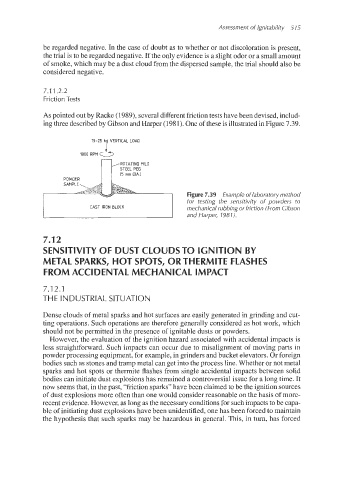Page 548 - Dust Explosions in the Process Industries
P. 548
Assessment of lgnitability 5 7 5
be regarded negative. In the case of doubt as to whether or not discoloration is present,
the trial is to be regarded negative. If the only evidence is a slight odor or a small amount
of smoke, which may be a dust cloud from the dispersed sample, the trial should also be
considered negative.
7.1 1.2.2
Friction Tests
As pointed out by Racke (1989), several different friction tests have been devised, includ-
ing three described by Gibson and Harper (1981). One of these is illustrated in Figure 7.39.
c
15-25 kg VERTICAL LOAD
1000 RPll a
ROTATING MILD
STEEL PEG
(5 mm DIA.)
POWDER
Figure 7.39 Example of laboratory method
for testing the sensitivity of powders to
CAST IRON BLOCK mechanical rubbing or friction (From Gibson
and Harper, 198 1).
7.1 2
SENSITIVITY OF DUST CLOUDS TO IGNITION BY
METAL SPARKS, HOT SPOTS, OR THERMITE FLASHES
FROM ACCIDENTAL MECHANICAL IMPACT
7.12.1
THE INDUSTRIAL SITUATION
Dense clouds of metal sparks and hot surfaces are easily generated in grinding and cut-
ting operations. Such operations are therefore generally considered as hot work, which
should not be permitted in the presence of ignitable dusts or powders.
However, the evaluation of the ignition hazard associated with accidental impacts is
less straightforward. Such impacts can occur due to misalignment of moving parts in
powder processing equipment, for example, in grinders and bucket elevators. Or foreign
bodies such as stones and tramp metal can get into the process line. Whether or not metal
sparks and hot spots or thermite flashes from single accidental impacts between solid
bodies can initiate dust explosions has remained a controversial issue for a long time. It
now seems that, in the past, “friction sparks” have been claimed to be the ignition sources
of dust explosions more often than one would consider reasonable on the basis of more-
recent evidence. However, as long as the necessary conditions for such impacts to be capa-
ble of initiating dust explosions have been unidentified, one has been forced to maintain
the hypothesis that such sparks may be hazardous in general. This, in turn, has forced

